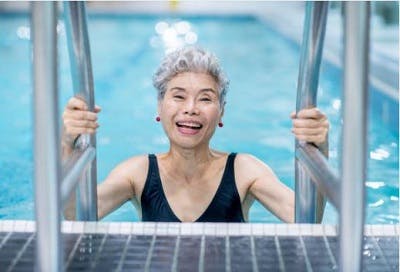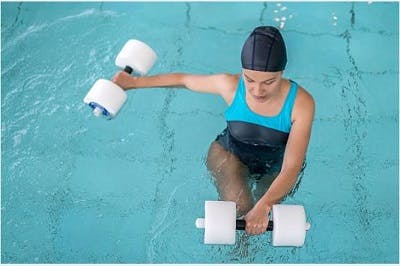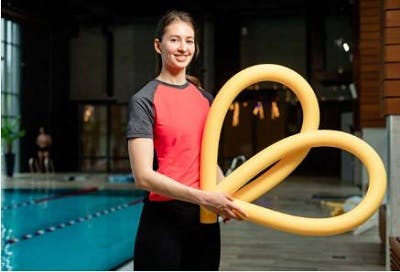Aquatic therapy for spinal cord injury rehabilitation is an effective way to develop balance, strength, and movement patterns. Aquatic therapy is a safe form of physical therapy for survivors when supervised by a trained physical therapist.
A physical therapist can provide various pool exercises for spinal cord injury suited to your ability level that can help boost recovery. Aquatic therapy exercises can help reduce stress on the joints, making it easier to move in the water, which many survivors especially love.
Many pools are also located indoor or outdoor, and this change of scenery is another reason why many survivors find aquatic therapy fun and motivating.
This article will discuss popular pool exercises for spinal cord injury that you can try with a caregiver or therapist. But first, let’s take a look at the additional benefits and the risks of engaging in aquatic therapy after sustaining a spinal cord injury.
What Are the Benefits of Aquatic Therapy After SCI?

Every spinal cord injury is different and every survivor may experience different secondary effects depending on the severity and level of injury. A common secondary effect after spinal cord injury is spasticity, or involuntary muscle contractions. Spasticity is caused by disrupted signals between the brain and areas below the level of injury.
Spasticity is triggered by movement and is also velocity-dependent. This means the quicker a muscle is stretched, the more severe the contraction, which can lead to stiff movements and jerky spasms.
Fortunately, research shows that aquatic therapy can help reduce the effects of spasticity after spinal cord injury. Studies also found that pool exercises after spinal cord injury can help improve body composition, strength in the muscles, and reduce pain.
Water holds several inherent benefits that help promote mobility after spinal cord injury, particularly buoyancy, viscosity, and hydrostatic pressure.
Here are several benefits that aquatic therapy for spinal cord injury provides:
1. Reduce Pressure on the Joints
After a spinal cord injury, survivors may experience muscle atrophy which refers to the shrinking of muscles. This primarily occurs due to lack or mobility of the muscles, which can be challenging especially for survivors with paraplegia or quadriplegia. Fortunately, the benefits of buoyancy can help reverse muscle atrophy, and encourage mobility.
Buoyancy is the way a body can float or rise when submerged in water. It’s what makes you feel light in the water and helps keep you afloat. Buoyancy is effective because it helps relieve pressure from your joints. With less weight to bear, it becomes easier for spinal cord injury patients to focus on movement, balance, and correct their gait.
Spinal cord injury survivors can increase the difficulty level of their exercises by moving into shallower water. Over time, and with consistent practice, this will help accustom the joints to bearing more weight.
2. Strengthen Muscles
Water can also help promote recovery after spinal cord injury through drag force and viscosity. Drag force is the resistance of a fluid against an object in motion, whereas viscosity refers to the resistance of a fluid at a given rate.
When it comes to a body of water like a pool, viscosity is what adds resistance and makes it challenging to move at a fast pace. However, this is actually beneficial during spinal cord injury recovery because it helps strengthen the muscles. Viscosity can also help improve joint flexibility and reduce stiffness in the knees.
Additionally, the resistance of water is greater than air, which is why movement with the same amount of energy is slowed down in water. In order to maintain normal speed underwater, the muscles must exert more effort, which develops strength.
Lack of movement due to a spinal cord injury can often cause muscle atrophy, especially for individuals in a wheelchair. Therefore, the benefits of drag force and viscosity are essential because it increase endurance, reduce the hyperactivity of spastic muscles, and promote full range of motion.
3. Relieve Pain
Hydrostatic pressure is the force exerted by the water in every direction onto your body. It is directly influenced by the density of water and depth of submersion, meaning the lower you submerge in water the greater the hydrostatic pressure.
In addition to muscle atrophy, lack of mobility in the affected limbs can also cause swelling in some cases. This occurs when excessive fluid builds up in the muscles. Fortunately, hydrostatic pressure is an excellent property of water that can help reduce swelling and promote recovery.
Hydrostatic pressure can help improve range of motion in the joints and reduce spasticity. It provides constant compression that, when paired with heat from a warmed pool, can stimulate the nerve endings to block pain signals. Compression and heat also help increase blood circulation throughout the body. This enables a more efficient delivery of oxygen and other essential nutrients necessary to relax tight muscles and promote healing.
4. Promote Body Awareness
Drag force can create a slow-moving environment that promotes proprioception, or body awareness in relation to space. This allows more time for survivors to react and think about every movement being made.
While it may not seem like it, the added resistance in water helps create a safe, rehabilitative environment (under the right guidance and supervision) because it minimizes the impact of a fall. This can help reduce the fear of falling and encourage SCI survivors to actively participate in pool exercises.
5. Boost Confidence
Spinal cord injury rehabilitation can be both physically and mentally challenging. Therefore, it’s important to keep yourself motivated to practice high repetition of exercises to stimulate neuroplasticity, the central nervous system’s ability to rewire itself. Aquatic therapy is perfect for this.
Neuroplasticity strengthens existing neural connections and creates new ones, which are essential for restoring function after spinal cord injury. Aquatic therapy can help boost your confidence to help you stay focused, stimulate neuroplasticity, and promote recovery.
Exercising in water undoubtedly is one of the most effective forms of physical therapy. Now that you know the top five benefits of aquatic therapy for spinal cord injury, let’s take a look at the various types of pool exercises survivors can engage in.
Is Aquatic Therapy Safe for All SCI Survivors?
While aquatic therapy can be beneficial during spinal cord injury rehabilitation, it’s important for every survivor to take extra precaution. There are several special considerations that need to be considered before engaging in pool exercises to ensure aquatic therapy is a safe option.
For example, it’s best for survivors with pressure sores to avoid getting in the water because moisture can increase the risk of infection, making the skin more susceptible to breakdown.
Similarly, survivors with an injury level of T6 and above may be at a higher risk for complications such as autonomic dysreflexia, which can cause difficulties with body temperature regulation. Immersing in water or exercising in a heated pool can cause overheating and result in hypertension, arrhythmia, or fever.
Always be sure to work with a trained physical therapist before engaging in pool exercises after a spinal cord injury. They are a great resource and can offer suggestions on how to manage complications and secondary effects. It’s also important to always wear a life vest when performing aquatic activities to further ensure your safety and wellbeing.
Aquatic Therapy Exercises for Spinal Cord Injury Recovery

There are a wide variety of aquatic therapy techniques that focus on developing balance, speed, and strength. Depending on your ability level, certain techniques may be more ideal than others. Many pool exercises can be active or passive, meaning they can be performed on your own or with your therapist.
Passive exercise is especially effective for survivors who struggle with limited mobility. As previously mentioned, many spinal cord injury survivors experience lack of movement in the affected muscles.
To prevent swelling or other complications, your muscles need to be moving. Thus, passive movement is great for helping you maintain movement as you build the strength to move your muscles on your own.
Here are some of the most effective aquatic therapy techniques for spinal cord injury survivors:
Watsu Technique (Passive)
The Watsu Technique is a passive form of aquatic therapy, meaning the survivor does not have to exert great amounts of energy or force. Rather, a physical therapist will help move the affected limbs for them in warm water. This can include passive movements such as cradling, stretching, and massaging the body to relieve muscle tightness. This also helps to increase full range of motion.
Bad Ragaz Ring Method (Passive)
The Bad Ragaz Ring Method is another passive technique involving survivors floating on their back while wearing floating rings around their neck, arms, torso, and ankles. During this aquatic therapy session, survivors lie in a supine (upward) position in either waist or shoulder deep water. This is a guided method that focuses on expanding range of motion and promoting body awareness.
Halliwick Method (Passive or Active)
The Halliwick Method helps improve balance, posture, and motor control. Exercises that use this method include transverse rotation control, which focuses on being able to control movements around a transverse axis of the body like rocking in a chair. With these types of exercises it’s normal to lose balance but don’t be discouraged, try to get up and try again.
Aqua Jogging (Active)
Engaging in Aqua Jogging after spinal cord injury helps reduce impact on the joints and improve form. When performing these exercises, survivors wear floating vests to help them stand upright and maintain a good posture when jogging or walking in the water.
Burdenko Method (Active)
The Burdenko Method can help build strength and improve flexibility in the affected muscles. Burdenko exercises focus on developing balance, coordination, and endurance and utilizes specialized equipment such as floatation vests, water barbells, resistance bands, and boards. When using the Burdenko Method, you first learn how to move submerged in deep water with a light floatation vest on.
With your body supported, it can move with more ease without having to fight the pulling forces of gravity. You may encounter resistance which helps develop strength in the muscles when performing these exercises.
Ai Chi (Therapeutic)
Ai Chi is a therapeutic form of aquatic therapy that focuses on deep breathing and balance through slow, controlled movements underwater. This relaxation technique helps promote fluid movements and reduce stiffness in the muscles. Ai Chi exercises use diaphragmatic breathing techniques and active resistance training to integrate both the mind and body.
Thus, aquatic therapy is an engaging form of physical therapy that provides many benefits during spinal cord injury recovery.
Now, let’s take a look at some of the most effective pool exercises for spinal cord injury. Be sure to only perform these exercises when safe and supervised by a physical therapist.
Advanced Pool Exercises for Spinal Cord Injury

To get the most out of pool exercises after spinal cord injury it helps to pay extra attention to your movement and form. For instance, try to keep your back straight and avoid leaning forward when looking down at your feet. This will allow you to take advantage of the benefits of buoyancy, viscosity, and hydrostatic pressure.
Your caregiver or therapist can also help you and ensure these exercises are safe for your unique condition. It’s also recommended to use a noodle or a floating board for better stabilization in the water.
Here are some of the most effective pool exercises for spinal cord injury:
1) Wide-Based Steps
Before engaging in rigorous pool exercises, it first helps to feel and get comfortable with the water. This exercise can help you get there.
To start, create a wide base by standing with your legs far apart (the further apart, the more stable your base will be). Once you’re in a stable position, take a few steps forward and then a few steps backward.
When stepping, make sure your feet are facing forward and that at least one foot is always on the ground. Avoid hopping from one foot to the other. You can ask your therapist or caregiver to help you balance.
After stepping forward or backward, return to your starting position and adjust your legs to have them closer together. Then, take a few steps forward and back again until your legs are a normal walking-width apart.
2) High Kicks
For this next pool exercise, you’re going to slowly swing your foot forward and straighten the knee as you extend your leg up. Then, hold for a second or two before lowering your foot. Alternate between each leg for 15-20 kicks or as many as you can.
This exercise will engage your core, help stretch your hamstrings, and strengthen your lower body. Be extra careful when practicing high kicks to not overwork your muscles. Only practice as much as you can safely accomplish.
3) Side Steps
To practice side steps, hold onto the edge of the pool with a caregiver or therapist staying near you for added balance. Then, slowly take 15 steps to the right and then 15 steps to the left. With your feet moving they tend to point to the side but make sure they remain facing forward.
If you feel comfortable moving from side to side, you can try to release your grip from the edge of the pool and practice side-stepping without holding onto anything. Practicing side steps in the pool can encourage greater range of motion at the hip joint and strengthen hip muscles that help stabilize your pelvis.
4) Heel-to-Toe
This pool exercise focuses on the mechanics involved in walking. To begin, practice walking in slow motion. Then, you can try exaggerated movements such as the transition from heel to toe or the bending and straightening of the knees. With this pool exercise it’s easier to understand how your weight shifts as you walk.
5) Step-Ups
For this pool exercise, you will need to utilize the built-in stairs and rail (found in most pools).
To begin, place your right foot onto the step and then press onto the right heel as you straighten your right knee. Then, bring your left leg to meet your right leg. Use the rail to help you maintain balance and prevent any falls or injury.
Push up with the leading leg, not the lower one. To continue, step back down and alternate with your other leg. Practicing these step-ups will help strengthen your quads (the muscles at the front of your thighs) and glutes
It’s important to note that as you step up, less of your body will be submerged in the water, meaning there may be extra pressure on the joints. Therefore, be sure to take a break or stop if you feel any pain or discomfort.
Modifying Pool Exercises for Spinal Cord Injury

While a caregiver or physical therapist can provide support and assist you in aquatic therapy exercises, there are various ways to modify pool exercises for spinal cord injury. Survivors can adjust many of these exercises to either increase or decrease the level of difficulty.
For example, to make them more simple you can try to:
- Reduce the number of steps you take. This can be applied to exercises like the Aqua Jogging or Side Steps.
- Hold onto a floating board or noodle. Even if the exercise may not necessarily require one you can hold onto one for balance and support.
- Slow your movements down. While it may be exciting or it may feel easier to speed up your movements in the water, be mindful to not overwork or strain your affected muscles.
To increase the challenge level in your exercises you can try to:
- Practice in shallower water. Greater buoyancy is found in shallow water, which can help reduce pressure on the joints while increasing the level of difficulty.
- Wear weighted cuffs. These can add more resistance to your exercises but be sure to only wear them with a caregiver or physical therapist to prevent any risk or injury.
- Increase speed. If you have slowed down your movement but feel comfortable enough, you may increase the speed of your exercises to make it more challenging.
Additionally, you may perform more or less repetitions depending on how much endurance you have built or would like to do. The more repetitions you do, the more neuroplasticity is stimulated, and mobility improved.
Improving Mobility with Aquatic Therapy for Spinal Cord Injury
Aquatic therapy for spinal cord injury is a great way to promote recovery. The properties in water like buoyancy, viscosity, and hydrostatic pressure all provide unique benefits, such as making movement easier to accomplish.
Pool exercises for spinal cord injury help reduce pressure in the muscles, spasticity, and pain without straining the joints.They can be performed actively or passively with a physical therapist. Always be sure to work with an experienced physical therapist before diving into these exercises to make sure they are safe for you.
We hope this article has helped you understand how aquatic therapy after spinal cord injury can be both fun and therapeutic.
The post Aquatic Therapy for Spinal Cord Injury: Promoting Recovery with Pool Exercises appeared first on Flint Rehab.



